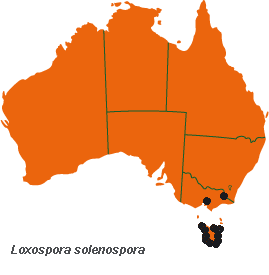



Australian Biological Resources Study
| Checklist of the Lichens of Australia and its Island Territories | ||
| Introduction | A–D | E–O | P–R | S–Z | Oceanic Islands | References | ||
| Loxospora solenospora (Müll.Arg.) Kantvilas | ||
| Herzogia 14: 36 (2000); Lecanora solenospora Müll.Arg., Bull. Herb. Boissier 1: 38 (1893). T: Warburton, Vic., Dec. 1885, F.R.M.Wilson 463; holo: G; iso: NSW. ****Sarrameana tasmanica Vězda & Kantvilas, Lichenologist 20: 179 (1988). T: Little Fisher R., Tas., 41°45’S, 146°20’E, 15 May 1987, G.Kantvilas 63/87 & J.Jarman; holo: HO; iso: distributed as A.Vězda, Lich. Sel. Exsicc. 2200. | ||
| Thallus greyish white, thin, smooth to rather verrucose. Apothecia 0.5–1.3 mm diam., lecideine; margin pale brown to ±translucent greyish, persistent, covered or surrounded by an entire or ragged whitish thalline layer and appearing lecanorine at least when very young; disc pale to deep reddish brown to blackish brown, mostly plane, pale grey-pruinose or becoming epruinose with age. Excipulum hyaline, inspersed with red-brown granules, K+ fleeting yellow and dissolving; hyaline thalline tissue surrounding excipulum K+ yellow. Epithecium composed of dense red-brown to yellow-brown granules, K+ fleeting yellow and dissolving in part. Hymenium hyaline, inspersed with oil droplets to 7 µm diam., also with occasional red-brown granules, K+ fleeting yellow and dissolving. Paraphyses simple, with apices hyaline or pale brownish. Hypothecium hyaline or with reddish brown granules, K+ fleeting yellow, dissolving. Ascospores narrowly ellipsoidal to broadly fusiform, simple or very rarely with 1 or 3 septa, curved, (18–) 20–33 × 4.5–6.0 µm. Pycnidia very rare, immersed, visible as minute black dots c. 0.05 mm wide. Conidia 3–4 × 0.5 µm. CHEMISTRY: Thamnolic acid almost always present; very rarely containing gyrophoric acid, either alone or in addition to thamnolic acid. Spot tests with standard reagents are generally unreliable for detecting these compounds as they may be present only in low concentrations or the thalli may be very thin. |  |
|
| Occurs in Vic. and Tas., typically as an epiphyte in cool-temperate rainforest and associated vegetation; it colonises the smooth bark of young saplings, canopy twigs and branches. Also known from New Zealand. | ||
| Kantvilas (2004d) | ||
| Checklist Index |
| Introduction | A–D | E–O | P–R | S–Z | Oceanic Islands | References |
This work is copyright. Apart from any use as permitted under the Copyright Act 1968, no part may be reproduced by any process without prior written permission from Australian Biological Resources Study. Requests and inquiries concerning reproduction and rights should be addressed in the first instance to Dr P. McCarthy. These pages may not be displayed on, or downloaded to, any other server without the express permission of ABRS.